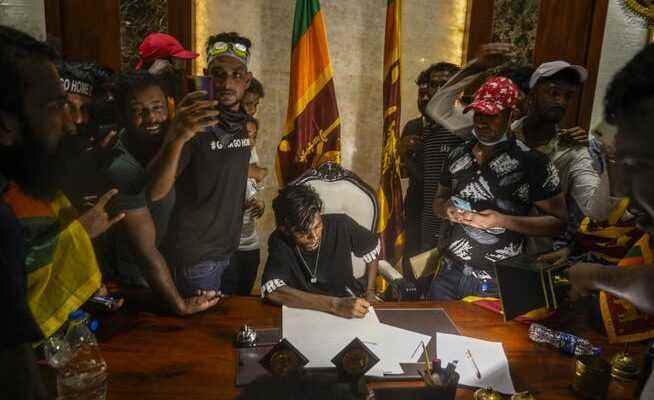Controversial President Gotabaya Rajapaksa has fled Sri Lanka and appointed the prime minister as interim president. Now his resignation has been made official.
Protesters behind a desk in Prime Minister Ranil Wickremesinghe’s office after storming it. Wickremesinghe was appointed interim president on Wednesday.
Sri Lanka’s President Gotabaya Rajapaksa emailed a letter of resignation on Thursday, a day late. The letter had to be checked for authenticity by the office of the speaker of the parliament before the resignation could be made official. But that has now happened: the parliamentary spokesman said on Friday that the resignation request had been accepted.
Rajapaksa fled to the nearby Maldives with his wife in a military plane on Wednesday. He flew on to Singapore on Thursday, the Reuters news agency reported. Singapore’s foreign minister said Rajapska was there privately and had not asked for asylum, according to the agency.
The previous prime minister, Ranil Wickremesinghe, will take over the official business on an interim basis.
The interim president had already announced the nationwide state of emergency on Wednesday and imposed a curfew in the western province of the country. This should also apply again on Friday night. The ordinary election of a new President by Parliament is scheduled for July 20th.
Weeks of protests preceded Rajapaksa’s flight. Over the weekend, citizens set fire to Prime Minister Wickremesinghe’s private residence and stormed the Sri Lankan presidential palace.
On Thursday, the protesters announced that they had agreed to withdraw from the palace and other buildings. A spokesman for the demonstrators announced at a press conference in the capital Colombo on Thursday that the official residences and offices of the president and prime minister would be returned to the state. However, the protest in front of the presidential seat is to be continued. Shortly before that, the Sri Lankan Bar Association had announced that it would no longer defend the protesters free of charge, for example in the case of arrests if they continued to occupy state buildings illegally.
The demonstrators demanded the resignation of the 73-year-old president as well as the prime minister of the same age, who is now serving as interim president. Since his appointment as interim president, Wickremesinghe has not repeated a previously made offer to resign. Wickremesinghe has only been in office since May, when he replaced the fugitive president’s brother, Mahinda Rajapaksa.
The military should restore order
Hundreds tried to storm the prime minister’s office on Wednesday afternoon, but were initially held back by police. They fired tear gas at the crowds besieging the building. There are said to have been injuries. Only a few hours later, a crowd managed to break into the office. Armed soldiers who were outside the prime minister’s office did not intervene.
Sri Lanka declares a state of emergency as thousands mob the prime minister’s office after the country’s president fled to the Maldives, following months of widespread protests over the economic crisishttps://t.co/lo8gf8sJI3
? Police fire tear gas as thousands mob PM’s office pic.twitter.com/P2U4SxFDJS
— AFP News Agency (@AFP) July 13, 2022
Shortly thereafter, Wickremesinghe had ordered the military to do whatever was necessary to restore public order. He called on the demonstrators to cooperate with the authorities. “We must put an end to the fascist threat to our democracy,” said the incumbent president in a televised address.
After the speech, he criticized Sri Lankan opposition leader Sajith Premadasa, that Wickremesinghe had been appointed interim president. He has no support in parliament, and the occupation is a farce in the style of the deposed Rajapaksa clan. The family has dominated the country’s politics for years and is blamed by most Sri Lankans for the current problems.
A MP with one seat is appointed as PM. Now the same person is appointed as acting President. This is the Rajapaksa style of democracy. What a farce. What a tragedy.
— Sajith Premadasa (@sajithpremadasa) July 13, 2022
Sri Lanka’s army chief, Shavendra Silva, has reiterated that the military and police will respect the constitution. The political leadership must inform the public and the armed forces by Wednesday evening about how to proceed.
Economic misery as the reason for the crisis
The reason for the protests is the state’s worst economic crisis since independence from Great Britain in 1948. Petrol, electricity and gas for cooking have been in short supply for weeks, and medicine and food are also missing.
The country was no longer able to service its foreign debt, partly because foreign exchange earnings from the important tourism industry collapsed in the course of the pandemic. Sri Lanka officially went bankrupt in May. The inflation rate was recently over 50 percent, the central bank assumes that inflation could rise to up to 70 percent in the coming months.
Sri Lanka’s largest single creditor is China, while India has been the country’s biggest supporter since early January – with more than $3.5 billion in loans and aid. Sri Lanka is also in talks with the International Monetary Fund for fresh cash injections.
Whoever will lead the country in the future faces enormous challenges. A future president will not only have to placate angry protesters, but international believers as well.
With agency material.
